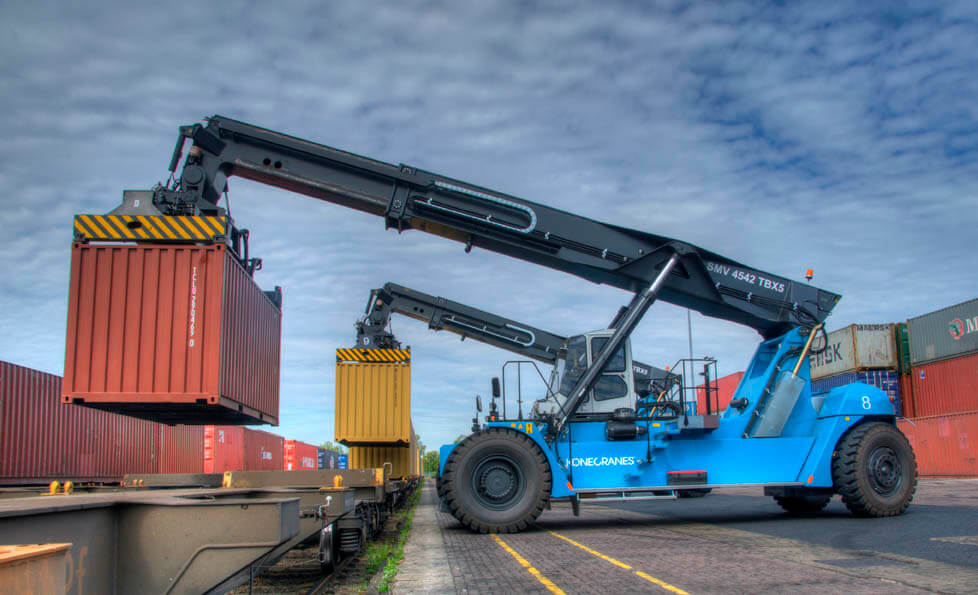PRCSH43 22nd December 2010
January has seen the introduction of stringent new regulations aimed at reducing emissions from off-road vehicles – including forklifts, container handlers and reachstakers – prompting a radical rethink in engine design, says David Cooper, Managing Director of Cooper SH, a leading supplier of specialists materials handling equipment to the logistics industry.
Furthermore the developments made in engine technology have the potential to provide much wider benefits for operators that go well beyond legal compliance – they can actually help to reduce costs and improve efficiency.
The implementation of EU stage 3b engine emission norms for off-road engines in the power range of 130kW – 560 kW also coincides with the US Environmental Protection Agency (EPA) Tier 4i emission controls and marks one of the most significant developments to date in the industry’s ongoing battle to improve environmental performance.
These efforts stretch back to the introduction of EU stage 1 regulations, first introduced in 1995, which targeted emissions of Nitrogen Oxides (Nox), Carbon Monoxide (CO) and particle matters (PM), otherwise known as soot or black smoke.
These early regulations saw significant reductions in all three emissions and Stage 3b represents the most challenging and bold progression yet, aiming for a further 50% fall in NOx and HC and a massive 90% in PM.
As a result, emissions from the latest vehicles will be a tiny fraction of the machines supplied as recently as 2002 when EU legislation was first introduced. In fact NOx and PM will be reduced as much as over 95% following the introduction of further legislation, EU stage 4, due for implementation in 2014.
To meet the new targets engine manufacturers have taken two distinct approaches; one harnessing the proven capabilities of existing engines by adding new filters, the other being based around a more radical redesign of engine architecture.
All engine manufacturers were faced with the fact that minimising PM during the in-cylinder combustion process has the effect of increasing the NOx proportionally.
This creates a paradox – do they minimise NOx and allow PM to flow freely and catch the soot in a filtration system or do they control the PM with a much cleaner burn and treat the NOx post burn?
One leading engine manufacturer, Cummins has opted for an EGR (Exhaust Gas Recirculation) to reduce NOx during the burn process in its existing range of engines. The downside of this is that PM or soot levels are increased and so they require the installation of additional filters that can have an impact on overall performance.
The approach taken by rival engine manufacturers Volvo and Scania, represents a more radical solution that involves the introduction of a Selective Catalytic Reduction (SCR) emission control system.
The SCR system, treats NOx by injecting a special additive – UREA (also known as ad-blue) – into the exhaust gases. As a result, Ad-blue is now an integral part of the fuel system, with its own separate tank and fuel gauge.
The addition of ad-blue and the disciplines associated with filling will be something users will have to become accustomed in the same way on-road users have been, but any perceived inconvenience is far outweighed by the benefits.
Just as road cars saw a significant drop in performance when the first emission controls were introduced so too have MH trucks. However, the Ad-blue solution frees engines of many of the restrictions placed upon them by additional filtration systems.
In fact engines will have significantly greater power and even as much as 25 to 50 per extra torque depending on the engine speed. As a result they will not have to work as hard to maintain the same level of performance, thus reducing fuel consumption by a further 5-10% whilst reducing wear and tear and associated maintenance costs.
When combined with other standard features across the range of Konecranes lift trucks, which feature SCR engines, further savings can be made whilst boosting environmental performance and efficiency. These features include engine settings that can be tailored around a specific customer application to optimise machine performance. Meanwhile fleet management tools such as Cooper’s EcoDrive represent a holistic approach managing both emissions and costs.
It has been estimated that fleet owners could save around £11,000 in fuel costs over the lifetime of a vehicle by monitoring driver behaviour using EcoDrive, an onboard computerised system that provides real-time information on the individual performance of the operator.
Overall it is clear that, rather than being a headache for fleet operators, the introduction of the new regulations offers the ideal opportunity to invest in technology that will improve their own financial, as well as environmental performance.
David Cooper is Managing Director of Cooper SH, UK’s largest independent supplier of Konecranes equipment for the logistics industry.
To keep up to date with Cooper Handling’s latest News please follow, tweet, link or like @CooperSHGroup
Editor’s Notes
Operating in all sectors of heavy lifting across the UK and Ireland, Cooper Specialised Handling is the exclusive UK distributor for SveTruck, RAM Spreaders, Telestack bulk material handling conveying systems and Sany mobile handling equipment, sole UK importer and exclusive distributor for Mantsinen cranes, Movella Translifters, TEC Containers and a long-term specialist in Konecranes lift trucks. The company, which celebrated 20 years in business in 2018, also has a dedicated after-sales division, Cooper Handling Solutions, which specialises in engineering support.
Independently owned, Cooper offers total solutions in both solids and bulk handling. Its customised solutions comprise high quality, high value products and reliable service for businesses operating in the most challenging heavy handling environments, including ports, freight handling, inter-modal terminals, manufacturing and other heavy lifting industries.
